Keswick, Cumbria
| Keswick | |
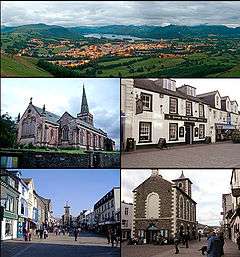 |
|
 Keswick |
|
| Population | 4,821 (2011)[1] |
|---|---|
| OS grid reference | NY270233 |
| Civil parish | Keswick |
| District | Allerdale |
| Shire county | Cumbria |
| Region | North West |
| Country | England |
| Sovereign state | United Kingdom |
| Post town | KESWICK |
| Postcode district | CA12 |
| Dialling code | 017687 |
| Police | Cumbria |
| Fire | Cumbria |
| Ambulance | North West |
| EU Parliament | North West England |
| UK Parliament | Copeland |
Coordinates: 54°36′00″N 3°07′45″W / 54.5999°N 3.1293°W
Keswick (/ˈkɛzᵻk/) is an English market town and civil parish, historically in Cumberland, and since 1974 in the Borough of Allerdale in Cumbria. The town, in the Lake District National Park, just north of Derwentwater, and 4 miles (6.4 km) from Bassenthwaite, had a population of 4,821 at the time of the 2011 census.
There is considerable evidence of prehistoric occupation of the Keswick area, but the first recorded mention of the town dates from the 13th century, when Edward I of England granted a charter for Keswick's market, which has maintained a continuous 700-year existence. In Tudor times the town was an important mining area, and from the 18th century onwards it has increasingly been known as a holiday centre; tourism has been its principal industry for more than 150 years. Its features include the Moot Hall; a modern theatre, the Theatre by the Lake; one of Britain's oldest surviving cinemas, the Alhambra; and the Keswick Museum and Art Gallery in the town's largest open space, Fitz Park. Among the town's annual events is the Keswick Convention, an Evangelical gathering attracting visitors from many countries.
Keswick became widely known for its association with the poets Samuel Taylor Coleridge and Robert Southey. Together with their fellow Lake Poet William Wordsworth, based at Grasmere, 12 miles (19 km) away, they made the scenic beauty of the area widely known to readers in Britain and beyond. In the late 19th century and into the 20th, Keswick was the focus of several important initiatives by the growing conservation movement, often led by Hardwicke Rawnsley, vicar of the nearby Crosthwaite parish and co-founder of the National Trust, which has built up extensive holdings in the area.
Name
The town is first recorded in Edward I's charter of the 13th century, as "Kesewik".[2] Scholars have generally considered the name to be from the Old English, meaning "farm where cheese is made", the word deriving from "cēse" (cheese) with a Scandinavian initial "k" and "wīc" (special place or dwelling), although not all academics agree. George Flom of the University of Illinois (1919) rejected that derivation on the grounds that a town in the heart of Viking-settled areas, as Keswick was, would not have been given a Saxon name; he proposed instead that the word is of Danish or Norse origin, and means "Kell's place at the bend of the river".[3] Among the later scholars supporting the "cheese farm" toponymy are Eilert Ekwall (1960) and A D Mills (2011) (both Oxford University Press), and Diana Whaley (2006), for the English Place-Name Society.[4][5][n 1]
Prehistory
Evidence of prehistoric occupation in the area includes the Castlerigg stone circle on the eastern fringe of the town, which has been dated to between 3000 and 2500 BC.[8] Neolithic-era stone tools were unearthed inside the circle and in the centre of Keswick during the 19th century. The antiquary W G Collingwood, commenting in 1925 about finds in the area, wrote that they showed "Stone Age man was fairly at home in the Lake District".[9] There is little evidence of sustained settlement in the area during the Bronze Age, but from excavations of hill forts it is clear that there was some Iron Age occupation, circa 500 BC, although scholars are not agreed about how permanent it was.[10]
In Roman Britain Cumbria was the territory of the Carvetii.[11] As the site of the western part of Hadrian's Wall, it was of strategic importance. The north of the county is rich in archaeological evidence from the period, but nothing is known that suggests any Roman habitation in the Keswick area, other than finds that point to the existence of one or more Roman highways passing the vicinity of the present-day town.[12] Such nearby settlements as can be traced from the era of the Romans and the years after their departure seem to have been predominantly Celtic. Many local place names from the period, including that of the River Derwent, are Celtic, some closely related to Welsh equivalents.[n 2]
Several Christian saints preached the Gospel in the north of England in the late 6th and early 7th centuries AD; in Keswick and the surrounding area the most important figures were St Herbert of Derwentwater and his contemporary St Kentigern.[14] The former, the pupil and friend of St Cuthbert of Lindisfarne, lived as a hermit on an island in Derwentwater, now named after him.[14] Kentigern, who lived and preached in the area before moving to Wales, is traditionally held to have founded Crosthwaite Church, which was the parish church of Keswick until the 19th century.[15]
History
Middle Ages
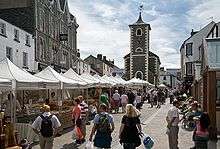
Keswick's recorded history starts in the Middle Ages. The area was conquered by the Anglo-Saxon Kingdom of Northumbria in the seventh century, but Northumbria was destroyed by the Vikings in the late ninth. In the early tenth century the British Kingdom of Strathclyde seized the area, and it remained part of Strathclyde until about 1050, when Siward, Earl of Northumbria, conquered Cumbria.[16] In 1092 William II of England, son of William the Conqueror, marched north and established the great baronies of Allerdale-below-Derwent, Allerdale-above-Derwent, and Greystoke, the borders of which met at Keswick.[17] In 1181 Jocelyn of Furness wrote of a new church at Crosthwaite, Keswick, founded by Alice de Romilly, the Lady of Allerdale, a direct descendant of William II's original barons.[18] In 1189, Richard I granted the rectory of Crosthwaite to the Cistercian order of Fountains Abbey.[19]
During the 13th century, agricultural land around the town was acquired by Fountains and Furness Abbeys. The latter, already prosperous from the wool trade, wished to expand its sheep farming, and in 1208 bought large tracts of land from Alice de Romilly. She also negotiated with Fountains Abbey, to which she sold Derwent Island in Derwentwater, land at Watendlath, the mill at Crosthwaite and other land in Borrowdale. Keswick was at the hub of the monastic farms in the area, and Fountains based a steward in the town, where tenants paid their rents.[17] Furness also enjoyed profitable rights to the extraction of iron ore.[20]
Grant to Thomas de Derwentewatere, and his heirs, of a weekly market on Saturday at Kesewik in Derewentfelles, co. Cumberland, and of a yearly fair there on the vigil, the feast and the morrow of St. Mary Magdalene, and the two days following.
Keswick was granted a charter for a market in 1276 by Edward I. This market has an uninterrupted history lasting for more than 700 years.[21] The pattern of buildings around the market square remained broadly the same from this period until at least the late 18th century, with houses – originally timber-framed – fronting the square, and sturdily enclosed gardens or yards at the back. According to local tradition these stout walls and the narrow entrances to the yards were for defence against marauding Scots. In the event it appears that the town escaped such attacks, Scottish raiders finding richer and more accessible targets at Carlisle and the fertile Eden Valley, well to the north of Keswick.[22]
16th and 17th centuries: agriculture and industry

With the Dissolution of the Monasteries, between 1536 and 1541, Furness and Fountains Abbeys were supplanted by new secular landlords for the farmers of Keswick and its neighbourhood. The buying and selling of sheep and wool were no longer centred on the great Abbeys, being handled locally by the new landowners and tenants. This enhanced Keswick's importance as a market centre, though at first the town remained only modestly prosperous: in the 1530s John Leland wrote of it as "a lytle poore market town".[23] By the second half of the century copper mining had made Keswick richer: in 1586 William Camden wrote of "these copper works not only being sufficient for all England, but great quantities of the copper exported every year" with, at the centre, "Keswicke, a small market town, many years famous for the copper works as appears from a charter of king Edward IV, and at present inhabited by miners."[24]
Earlier copper mining had been small in scale, but Elizabeth I, concerned for the defence of her kingdom, required large quantities of copper for the manufacture of weapons and the strengthening of warships. There was the additional advantage for her that the Crown was entitled to royalties on metals extracted from English land.[25] The experts in copper mining were German, and Elizabeth secured the services of Daniel Hechstetter of Augsburg, to whom she granted a licence to "search, dig, try, roast and melt all manner of mines and ores of gold, silver, copper and quicksilver" in the Keswick area and elsewhere.[25]
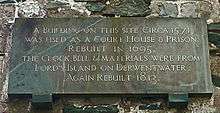
As well as copper, a new substance was found, extracted and exploited: this was variously called wad, black lead, plumbago or black cauke, and is now known as graphite. Many uses were quickly discovered for the mineral: it reduced friction in machinery, made a heat-resistant glaze for crucibles, and when used to line moulds for cannonballs, resulted in rounder, smoother balls that could be fired further by English naval cannon.[26] Later, from the second half of the 18th century, it was used to make pencils, for which Keswick became famous.[26]
The copper mines prospered for about seventy years, but by the early 17th century the industry was in decline. Demand for copper fell and the cost of extracting it was high.[27] Graphite mining continued, and quarrying for slate began to grow in importance. Other small-scale industries grew up, such as tannery and weaving. Although the boom of the mid-16th century had finished, the town's economy did not slide into ruin, and the population remained generally constant at a little under 1,000.[28]
18th and 19th centuries: beginnings of tourism
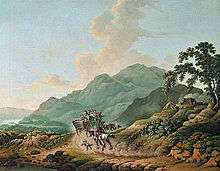
The historian George Bott regards John Dalton (1709–63) and John Brown (1715–66) as the pioneers of tourism in the Lake District. Both wrote works praising the majesty of the scenery, and their enthusiasm prompted others to visit the area. The poet Thomas Gray published an account of a five-day stay in Keswick in 1769, in which he described the view of the town as "the vale of Elysium in all its verdure", and was lyrical about the beauties of the fells and the lake.[29] His journal was widely read, and was, in Bott's phrase, "an effective public relations job for Keswick."[30] Painters such as Thomas Smith of Derby and William Bellers also contributed to the influx of visitors; engravings of their paintings of Cumberland scenery sold in large numbers, further enhancing the fame of the area.[30] In 1800 the Romantic poet Samuel Taylor Coleridge wrote, "It is no small advantage that for two-thirds of the year we are in complete retirement – the other third is alive & swarms with Tourists of all shapes & sizes."[31] Coleridge had moved to Keswick in that year, and together with his fellow Lake Poets (see below) was possibly the strongest influence on the public esteem of Keswick and the Lake District.[32]
During the 18th century and into the 19th, turnpike trusts were established and major roads in Cumberland were greatly improved.[33] With the Lake District now accessible by coach the area attracted well-off visitors, particularly at times of war in mainland Europe, which made the aristocratic Grand Tour impossible there.[34] Regular public coach services were established in the 1760s, but they were expensive. The ten-hour journey from Whitehaven to Penrith via Keswick cost 12 shillings (equivalent to 60 pence), at a time when country labourers typically earned £24 a year or less, and the annual income of even the most prosperous tenant farmers was rarely more than £200.[35] Nonetheless, by the 19th century the number of tourists visiting Keswick during each season was estimated at between 12,000 and 15,000.[36] Some of the Keswick inns that catered for affluent visitors remain as hotels, including the Queen's, where Gray stayed.[34]
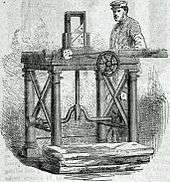
The construction of the railways in the mid-19th century made the Lake District, and Keswick in particular, more accessible to visitors of modest means. The original impetus for building the Cockermouth, Keswick and Penrith Railway (CKP) line came from heavy industry: the new Bessemer process of steelmaking brought a great demand for the rich iron ore from west Cumberland and the coking coal from Durham on the east side of the country. The CKP was built to enable ore and coal to be brought together at steel foundries in both counties.[37] The line opened for goods traffic in 1864, and the following year it began to carry passengers.[38] Fares varied, but holidaymakers could buy excursion tickets at discounted prices, such as six shillings for the 170-mile return journey from Preston to Keswick.[39]
In addition to its growing importance as a tourist centre, Keswick developed a reputation for its manufacture of pencils during the 19th century. It had begun on a modest scale in or about 1792, as a cottage industry, using graphite mined locally. This developed on more industrial lines in factories purpose-built by several companies. Pencil making was the town's most important manufacturing industry by the mid-19th century, textiles and leather goods having declined.[40]
The Moot Hall was rebuilt in 1813, and the lower floor was used as a market house on Saturdays. Coal gas was supplied by a gas works from 1846; the Keswick library opened in 1849;[41] a water works began operation in 1856; and Keswick police station opened in 1857.[42] The local weekly newspaper, The Keswick Reminder was founded in 1896, and in 2014 continues to be published every Friday. In an article in The Observer in 1978, Christopher Brasher wrote that as long as the Reminder flourishes, "there will be one corner of these islands that is forever England."[43]
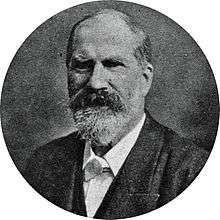
In 1883 Hardwicke Rawnsley was appointed vicar of Crosthwaite. In a study of Lake District towns in 1974, H A L Rice commented that to write about Keswick without mentioning Rawnsley would be the equivalent of writing about Stratford-upon-Avon without mentioning Shakespeare, so great was Rawnsley's impact on the town. He and his wife set up classes to teach metalwork and wood carving; these grew into the Keswick School of Industrial Art, which trained local craftsmen and -women from 1894 until it closed in 1986.[44] He revived the ancient May Day festival in the town, and was a leading figure in the establishment of Keswick School,[45] Blencathra Sanatorium and the County Farm School.[46] As co-founder of the National Trust, Rawnsley contributed to Keswick's continued growth as a tourist centre, with the acquisition by the Trust of many acres of popular scenic land around Derwentwater, beginning with Brandelhow Wood in 1902.[47]
20th century and beyond
Keswick's history throughout the 20th century was one of increasing reliance on tourism, the pencil industry being the second largest source of employment. The Cumberland Pencil Company, formed at the turn of the century, occupied a large factory near the River Greta on the road leading out of Keswick towards Cockermouth.[48] The conservation movement continued to develop; Rawnsley led successful campaigns to save the medieval Greta and Portinscale bridges from replacement with ferro-concrete structures;[49] and the National Trust continued to acquire land locally.[50] In the First World War Keswick lost many of its young men: the war memorial near Fitz Park commemorates 117 names,[51] from a population at the time of less than 4,500.[52] By the 1930s Keswick was firmly established as the main centre of tourism in Cumberland and Westmorland. An article in The Manchester Guardian in 1934 called it "the capital of the Lake District", and continued:
Keswick's chief industry is to promote the contentment and happiness of its visitors. Its pleasant position provides at the outset a tonic atmosphere ... it is set in the most delightful part of a delightful district, described by Wordsworth as "the loveliest spot that ever man has found." There are numerous places of interest and fine shops, and good accommodation is offered to visitors at reasonable prices. Keswick is the best centre from which to visit Lakeland.[53]
During the Second World War students from St Katharine's College, Liverpool and Roedean School, Sussex, were evacuated to Keswick when their own buildings were requisitioned for use as a hospital and a navy base respectively.[54] Students were also brought to the safety of Keswick from Central Newcastle High School,[55] Hunmanby Hall School, Yorkshire,[56] and the Liverpool Orphanage.[57]
The creation of the Lake District National Park in 1951, with strict control over new development, prevented any expansion of the town beyond its pre-war borders.[58] Keswick's population has remained stable at a little below 5,000 residents.[n 3] The town's reliance on tourism increased in 2006 when Cumberland Pencils moved production from Keswick to Lillyhall, Workington, only the Cumberland Pencil Museum remaining at the old site.[60] At the beginning of the 21st century, more than 60 per cent of the population were employed in hotels, restaurants and distribution. A survey of retail premises in 2000 found that more than ten per cent were outdoor clothes shops, a similar proportion were cafés or restaurants, and more than eight per cent were gift shops.[61] The age profile of the Keswick population is significantly higher than the English average. In 2011 children under 10 made up 7.6 per cent of the town's population, compared with 11.9 per cent for England as a whole. Between ages 10 and 20 the comparable figures are 10.2 and 12.1; and from ages 20 to 44, 25.9 as against 34.3. The percentage of Keswick's population aged 45 and upwards is above the national average, the largest difference being within the 75- to 84-year-old bracket, which contains 9.6 per cent of Keswick's population compared with a national average of 5.5.[62] Figures from the same census show that Keswick has fewer than average "large employers and higher managerial occupations" and more small employers and self-employed people. Long-term unemployment is considerably below the average for England.[n 4]
Ownership and governance
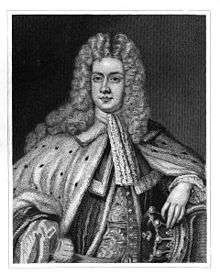
In medieval times the township was within the manor of Castlerigg and Derwentwater. The earliest surviving official record of the town is the market charter of 1276 granted to the lord of the manor, Thomas de Derwentwater. The manor was granted by Alice de Romilly to Adam de Derwentwater before 1216, and subsequently passed to the Radclyffe family through marriage. The Derwentwater estate was forfeit to the Crown after the execution of James Radclyffe, third Earl of Derwentwater, in 1716 for his part in the Jacobite rebellion the previous year.[64] In 1735 the Crown granted the income from the estates to support the Greenwich Hospital, London. Land to the south and west were part of Greenwich Hospital's forestry and farming estates until the 19th century.[64] In 1925 the then owner, Sir John Randles, gave the National Trust 90 acres of land in this estate, including the foreshore woodland.[65]
Keswick became a Local Government District in 1853 and an urban district with three wards in 1894, reflecting its growth in the latter part of the 19th century. The new urban district's northern boundary was extended from the Greta to the railway, taking in Great Crosthwaite and part of Underskiddaw in 1899. In 1974 the urban district was abolished and since then the town has been administered by Keswick Town Council and Allerdale Borough Council.[66] Since 2010 Keswick has been in the Copeland parliamentary constituency, having previously been part of Workington and before that Penrith and The Border.[67] The electoral ward of Keswick stretches beyond the confines of the parish boundary and at the 2011 Census had a total population of 5,243.[68]
Geography

Keswick lies in north-western England, in the heart of the northern Lake District. The town is 31.4 miles (50.5 km) south-west of Carlisle, 22.1 miles (35.6 km) northwest of Windermere and 14.2 miles (22.9 km) south-east of Cockermouth.[69] Derwentwater, the lake to the south-west of the town, is approximately 3 miles (4.8 km) long by 1 mile (1.6 km) wide and is some 72 feet (22 m) deep. It contains several islands, including Derwent Isle, Lord's Island, Rampsholme Island and St Herbert's Island, the largest. Derwent Isle is the only island on the lake that is inhabited; it is run by the National Trust and open to visitors five days a year.[70] The land between Keswick and the lake consists mainly of fields and areas of woodland, including Isthmus Wood, Cockshot Wood, Castlehead Wood and Horseclose and Great Wood, further to the south. The River Derwent flows from Derwentwater to Bassenthwaite, the most northerly of the major Cumbrian lakes. The Derwent and its tributary the Greta, which flows through Keswick, meet to the east of Portinscale.[69] The source of the Greta is near Threlkeld, at the confluence of the River Glenderamackin and St John's Beck.[71]
Keswick is in the lee of the Skiddaw group, the oldest group of rocks in the Lake District. These fells were formed during the Ordovician period, 488 to 443 million years ago;[72] they form a triangle sheltering the town, reaching a maximum height of 931m on Skiddaw itself.[73] To the west of Portinscale, to the south-west of the village of Thornthwaite, is Whinlatter Forest Park and Grisedale Pike.[69] To the east, beyond Castlerigg stone circle, is St John's in the Vale, at the foot of the Helvellyn range, which is popular with ramblers starting from Keswick. In 2010, Electricity North West, United Utilities, the Lake District National Park Authority and the conservation charity Friends of the Lake District invested £100,000 to remove power lines and replace them with underground cables, to improve the quality of scenery in the vicinity.[74]
Climatically, Keswick is in the North West sector of the UK, which is characterised by cool summers, mild winters, and high monthly rainfalls throughout the year.[75] The wettest months fall at the end of the year, the peak average of 189.3 mm falling in October. Rain, sunshine and temperature figures are shown below.
| Climate data for Keswick | |||||||||||||
|---|---|---|---|---|---|---|---|---|---|---|---|---|---|
| Month | Jan | Feb | Mar | Apr | May | Jun | Jul | Aug | Sep | Oct | Nov | Dec | Year |
| Average high °C (°F) | 7.2 (45) |
7.4 (45.3) |
9.4 (48.9) |
11.9 (53.4) |
15.6 (60.1) |
17.9 (64.2) |
19.7 (67.5) |
19.1 (66.4) |
16.7 (62.1) |
13.3 (55.9) |
9.7 (49.5) |
7.5 (45.5) |
12.95 (55.31) |
| Daily mean °C (°F) | 5.0 (41) |
4.0 (39.2) |
6.0 (42.8) |
10.0 (50) |
12.0 (53.6) |
15.0 (59) |
17.0 (62.6) |
16.0 (60.8) |
14.0 (57.2) |
10.0 (50) |
7.0 (44.6) |
4.0 (39.2) |
10 (50) |
| Average low °C (°F) | 1.6 (34.9) |
1.4 (34.5) |
2.8 (37) |
4.2 (39.6) |
6.4 (43.5) |
9.3 (48.7) |
11.5 (52.7) |
11. (52) |
9.0 (48.2) |
6.7 (44.1) |
3.9 (39) |
1.5 (34.7) |
5.78 (42.4) |
| Average precipitation mm (inches) | 169.1 (6.657) |
119.9 (4.72) |
127.8 (5.031) |
81.7 (3.217) |
79.4 (3.126) |
84.3 (3.319) |
88.1 (3.469) |
104.1 (4.098) |
126.6 (4.984) |
183.9 (7.24) |
177.9 (7.004) |
173.0 (6.811) |
1,521 (59.882) |
| Mean monthly sunshine hours | 93 | 112 | 155 | 210 | 217 | 218 | 240 | 217 | 150 | 155 | 90 | 33 | 1,943 |
| Source: UK Met Office and Holiday Weather[76] | |||||||||||||
Demography
The registers of Crosthwaite Church stated that there were 238 interments in 1623, believed to have been something between a twelfth and a tenth of the whole population of the parish at that time.[77] In the 1640s there was a sharp fall in population, brought on by the plague epidemic which affected Keswick, Carlisle, Cockermouth and Crosthwaite and other areas in 1645–47.[78]
In the 1801 census, the township of Keswick, including the town and surrounding hamlets, had a reported population of 1,350 people. The population grew at a steady rate, increasing to 1,683 in 1811, 1,901 in 1821, 2,159 in 1831, 2,442 in 1841, and 2,618 in 1851.[79] In 1871 the township had a population of 2,777 people.[80] The population grew at a faster rate towards the late 19th century and by 1901 it stood at 4,451 people.[81] There has been little fluctuation in population since, and in the 1991 census the town had a population of 4,836. In the 2001 census, 4,984 people were recorded, and 4,821 in 2011.[82] At the 2011 census, 57.9 per cent of the population identified as Christian, 31.5 per cent as non-religious, 1.2 per cent as Muslim and 8.3 per cent did not specify.[83]
Landmarks
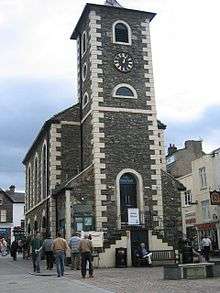
Keswick is the home of the Theatre by the Lake, opened in 1999.[84] The theatre serves a dual purpose as the permanent home of a professional repertory company and a venue for visiting performers and festivals.[85] It replaced the Century Theatre or "Blue Box", which had spent 25 years in semi-retirement on a permanent lakeside site in Keswick, after a career of similar length as a mobile theatre.[84][86] The Alhambra cinema in St John Street, opened in 1913, is one of the oldest continuously functioning cinemas in the country; it is equipped with digital technology and satellite receiving equipment to allow the live screening of plays, operas and ballet from the National Theatre, Royal Opera House and other venues.[87]
The town is the site of the Cumberland Pencil Museum. One of the exhibits is what is claimed to be the world's largest coloured pencil.[88] Fitz Park, on the bank of the River Greta, is home to the Keswick Museum and Art Gallery, a Victorian museum which features the Musical Stones of Skiddaw, Southey manuscripts, and a collection of sculptures and paintings of regional and wider importance, including works by Epstein, John Opie, Richard Westall and others.[89] After extensive restoration and enlargement the museum reopened in 2014.[90] In 2001 the cricket ground in Fitz Park was named the most beautiful in England by Wisden Cricket Monthly.[91]
Greta Hall (see Lake Poets, below), is a Grade I listed building. The home of Coleridge in 1800–04 and Southey from 1803 until 1843, it later became part of Keswick School and is now in private ownership, partly divided into holiday flats.[92] The three-storey house dates to the late 18th century and features a flush-panelled central double door with Gothic top panels and Venetian windows. A carved oak fireplace inside is dated to 1684.[93] The Moot Hall is a prominent Grade II* listed building situated at the southern end of Main Street. It was built in 1571 and rebuilt in 1695, and the current building dates to 1813. It is built of lime-washed stone and slate walling, and has a square tower on the north end with a round-arched doorway and a double flight of exterior steps.[94] At the top of the tower is what the Keswick Tourist Information Board describes as an "unusual one-handed clock". Formerly an assembly building,[95] The Moot Hall contains a tourist information centre on the ground floor, with an art gallery on the floor above.[96]
The prominent social thinker and art critic John Ruskin, who had many associations with Keswick, once said that the town was a place almost too beautiful to live in. In October 1900, mainly through the efforts of Rawnsley, a simple memorial of Borrowdale slate was erected to Ruskin at Friars Crag. The monument is a now a Grade II listed structure.[97]
Churches
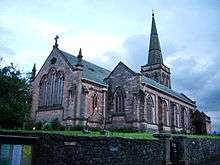
Until 1838 Keswick had no Anglican church within the town boundaries and was part of the widespread parish of Crosthwaite. The present parish church, St John's, was designed by Anthony Salvin and consecrated in 1838. It is geometrical in style, with pink castle-head ashlar sandstone and a slate roof. The church was extended in 1862, 1882 and 1889 by the parish's benefactors the Marshall family; the chancel windows, designed by Henry Holiday, installed in 1879, were taken down and reinstalled when the chancel was extended in 1889.[98] St John's became a Grade II* listed building in 1951.[99] Keswick's former parish church, St Kentigern's, at Crosthwaite, just outside the town, is also Grade II* listed. Dated to at least the 14th century, it is built mainly in the Tudor-Gothic style and was expanded in 1523 and later restored in 1844 by George Gilbert Scott.[100]
The Quakers had an early meeting house in the town, replaced in 1715 by one at Underskiddaw. Protestant dissenters met at a private house from 1705 or before, moving to a chapel in Lake Road in the latter part of the 18th century.[101] A Congregational chapel was built in 1858–59.[101] The first Wesleyan chapel was built in 1814 in a small yard off Main Street at a cost of £331 10s; the present Methodist church is in Southey Street.[102] Since 1928 Roman Catholics in Keswick have been served by Our Lady of the Lakes and St Charles in High Hill. A new Quaker meeting house opened in the town in 1994.[101] An Eastern Orthodox church was inaugurated in 2007, holding services in Keswick and the nearby village of Braithwaite.[103]
As at 2014 no other religions maintain dedicated buildings in Keswick; Muslim worship is accommodated on Fridays in a room at the local council building in Main Street.[104]
Public houses and hotels
Keswick's old inns and their successors include many listed buildings, mainly Grade II in designation.[105] The George Hotel, stated to be the oldest inn in the town, dates to the 16th century, with the alterations made during the Georgian period still evident.[106] The King's Arms Hotel, in the main market square, dates from the early 19th century; it is built from stuccoed stone, with Victorian shop windows on the ground floor.[107] The Queen's Hotel in Main Street, a pebbledashed stone building dating from the late 18th century, was renamed "The Inn on the Square" in 2015.[108] The Bank Tavern in Main Street and The Dog and Gun public house in Lake Road are both Grade II listed 18th-century buildings.[109][110]
The following are the listed buildings in Keswick. The listings are graded:[105]
- 10–15, Borrowdale Road (Grade II)
- 123 and 125, Main Street (Grade II)
- 17–23, St John's Street (Grade II)
- 18, High Hill (Grade II)
- 2, Eskin Street (Grade II)
- 25, St John's Street (Grade II)
- 3, Penrith Road (Grade II)
- 3–6, High Hill (Grade II)
- 36–50, St John's Street (Grade II)
- 4 and 6, Derwent Street (Grade II)
- 4 and 6, Eskin Street (Grade II)
- 6–12, Police Station Court (Grade II)
- 8 and 10, Eskin Street (Grade II)
- 85–91, Main Street (Grade II)
- Balustrading, Urns, and Terrace Wall to Garden on North Side of Castlerigg Manor (Grade II)
- Brigham Forge Cottages (Grade II)
- Calvert's Bridge (Grade II)
- Castlerigg Manor (Catholic Youth Centre) (Grade II)
- Castlerigg Manor Lodge (Grade II)
- Central Hotel (Grade II)
- Chestnut Hill House Shelley Cottage with Adjoining Stables and Coach House to North (Grade II)
- Church of St John (Grade II*)
- Church of St Kentigern (Grade II*)
- County Hotel (Grade II)
- Crosthwaite Sunday School (Grade II)
- Crosthwaite Vicarage (Grade II)
- Derwent Isle House (Grade II)
- Forge Bridge (Grade II)
- Formerly Mayson's Shop (Grade II)
- George Hotel (Grade II)
- Greta House (Grade I)
- Heads House (Grade II)
- Ivy Cottage (Grade II)
- Keswick Industrial Arts (Grade II)
- Keswick Railway Station Building and Platform (Grade II)
- King's Arms Hotel (Grade II)
- Oak Cottage Oak Lodge (Grade II)
- Oddfellows Arms Public House (Grade II)
- Packhorse Inn Including Attached Former Stables (Grade II)
- Police Station and Magistrates Court (Grade II)
- Priorholm Hotel (Grade II)
- Royal Oak Hotel (Grade II)
- Ruskin Monument (Grade II)
- Skiddaw Cottage (Grade II)
- Small Outbuilding Opposite Packhorse Inn and Behind Ye Olde Friars (Grade II)
- The Bank Tavern (Grade II)
- The Dog and Gun Public House (Grade II)
- The Moot Hall (Grade II*)
- The Old Chapel at Landing Stage (Grade II)
- Toll Bar Cottage (Grade II)
Education and health
The Crosthwaite Free Grammar School, adjoining Crosthwaite churchyard, was an ancient institution, its date of foundation uncertain.[111] In 1819 the parish of Crosthwaite had five or six schools in the town and the outlying areas, with a total of 332 children. By 1833 Keswick had twelve daily schools, including a new National School at High Hill.[112] The new parish church of Keswick, St John's, started educational work in 1840 with a Sunday school which also educated infant boys, and later girls, on weekdays. A full-time boys' school opened in 1853.[113] For older pupils, Keswick School, the free co-educational grammar school, successor to the Crosthwaite Free Grammar School, opened at a site diagonally opposite Greta Bridge in 1898.[114] In 1951 a new secondary modern school was built at Lairthwaite in Underskiddaw.[113]
Junior education is provided by St Herbert's School, which had a roll of 263 in 2013.[115][116] At senior level, Keswick and Lairthwaite schools merged in 1980 as a single comprehensive secondary school, with the name Keswick School. It was included in The Daily Telegraph's list of the top thirty comprehensives in England, Wales and Northern Ireland in 2014.[117] The Local Education Authority for Keswick is Cumbria.[118]
The Mary Hewetson Cottage Hospital, founded in 1892, has fifteen beds and a minor injuries unit.[119] It underwent a major rebuilding and upgrade in 2013.[120]
Sport
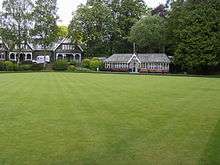
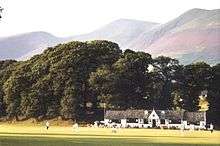
Keswick is home to Keswick Football Club. The principal team plays in the Westmorland League Division One, and it also has a reserve team which plays in Westmorland League Division Two, a female team which plays in the Cumbria League, juniors who compete in the under-16, under-14, under-12 and under-10 categories in the Penrith Junior Football League; there is a veteran team, which competes in the Cumbria League.[121] Keswick Rugby Union Football Club, established in 1879, plays at Davidson Park, and has teams that play in the Cumbrian League and the Cumbria Rugby Union Raging Bull Competition.[122] The rugby club is involved in the organisation of the Keswick Half Marathon, usually held in the first week of May.[123]
Keswick Tennis Club has grass courts in upper Fitz Park, and also runs hard courts on Keswick's Community Sports Area in the lower park area. Keswick Cricket Club was established in the 1880s. Its principal team competes in the North Lancashire and Cumbria Cricket League, Premier Division.[124] The second team plays in the Eden Valley Cricket League, 3rd Division, and the club also has junior under-11, under-13, and under-15 teams and a women's cricket team. Keswick Fitz Park Bowls Club was founded in 1882.[125]
In cycling, Keswick hosted the Keswick Bikes Borrowdale Cross of the North West League, second round, in September 2010 for junior riders, an event that was supported by the British Cycling Federation.[126] The same month, the town hosted an activity weekend for children, involving the juniors of the Brooke Steelers Wheelchair Basketball Team, whose senior players who were competing in a 135 miles (217 km) race from Keswick to Penrith to raise money for children's cancer.[127] Keswick is also home to Keswick Croquet Club, Keswick Archers, and Greta (Keswick) Junior Badminton Club, for children from eight to 16 years of age.[121] The town leisure centre, Keswick Leisure Pool and Fitness Centre, is operated and managed by Carlisle Leisure Limited (CLL), and has a pool and fitness facilities, and offers lessons in canoeing.[128]
Transport
Keswick is on the A66 road linking Workington and Penrith, as well as the A591, linking the town to Windermere, Kendal and Carlisle (via the A595).[129]
There are no rail links to Keswick; the line built in the 1860s for the Cockermouth, Keswick and Penrith Railway closed in 1972.[n 5] Since the 1990s a plan to rebuild it has been under discussion.[131] Some 90 percent of the earthworks of the railway still exist, but according to 2000 estimates, a reopening would cost £25 million.[132] In 2014 the only public transport serving the towns and villages on the old railway route is a bus service operating at mostly hourly intervals. The bus journey from the main line station at Penrith to Keswick takes a scheduled 47 minutes.[133]
The town is served by other bus routes providing direct connections with Carlisle, Cockermouth, Kendal, Lancaster, Penrith, Windermere, Workington, and other towns and villages in the north west.[134] The flow of traffic from Penrith to Cockermouth and beyond was eased after the A66 was diverted to a new bypass in 1974, a development that caused controversy because of a prominent new viaduct carrying the road across the Greta Gorge to the north of the town.[135]
The majority of visitors arrive by car and are catered for by three town centre car parks, another large one next to the Theatre by the Lake, and smaller ones elsewhere in the town.[136]
Culture
Regular events
Annual events in the town's calendar include the Keswick Film Festival (February–March). It features screenings of old and new films, interviews with directors, and the festival's Osprey Awards for short films by local filmmakers.[137] The ten-day Words by the Water literary festival is held in March every year, based at the Theatre by the Lake. The festival began in 1995, and events have been presented by Melvyn Bragg, Louis de Bernières, Germaine Greer, Steve Jones, Penelope Lively, Princess Michael of Kent, Michael Rosen and Joanna Trollope.[138]

In May each year, Keswick is host to three contrasting events. The Keswick Half Marathon, in the early part of the month takes participants around Derwentwater with an additional loop into Newlands Valley.[139] In the second week of May there is the four-day Keswick Jazz Festival, with more than 100 jazz events at a dozen local venues. Participants include British and international exponents of mainstream and traditional jazz.[139] After the Jazz Festival is the four-day Keswick Mountain Festival in mid-May. In the words of the organisers, the festival "celebrates everything we all love about the outdoors".[139] It includes ghyll scrambling, mountain biking, guided walks, map reading, canoeing, climbing, a triathlon and other events.[139]
The main event of the town's calendar in June is the Keswick Beer Festival, a two-day event that attracts more than 5,000 participants each year.[139] July is marked by the opening of the annual Keswick Convention, an international gathering of Evangelical Christians, described in 1925 as "the last stronghold of British Puritanism",[140] promoting biblical teaching and pious lifestyles.[141] Among those associated with the Convention have been Frank Buchman and Billy Graham.[142] The event has grown from a single week to three weeks, straddling the latter part of July and early August.[139]
In August, Keswick features the Derwentwater Regatta. It was inaugurated by the eccentric local landowner Joseph Pocklington in 1792,[143] and after a lapse of more than two centuries was revived in 2013.[144] Its organisers describe it as "A weekend of mayhem and madness afloat, with the chance to climb aboard in a variety of races on Derwentwater".[139] The Keswick Agricultural Show, founded in 1860, has traditionally been held on August Bank Holiday Monday at the western edge of the town on the Crossing Fields section of the open land known as the Howrahs.[n 6] The show features both commercial and charity stands, and attracts large numbers of competitors, exhibitors and spectators.[139] From 2014 the venue has changed to Pump Field, a few hundred yards further from the town centre towards Braithwaite.[146]
Classical music is presented throughout the year, both in conjunction with the Lake District Summer Music Festival[147] and independently through the Keswick Choral Society[148] and the Keswick Music Society, which was founded in 1947.[149] Performers in Keswick have included the Chilingirian Quartet,[147] the Royal Northern Sinfonia,[150] Tasmin Little,[151] the City of London Sinfonia,[149] Red Priest[149] and Nicolai Demidenko.[152]
Lake Poets and other Keswick notables

Coleridge and William Wordsworth were close friends and collaborators; when Wordsworth and his sister Dorothy took up residence in the Lake District in late 1799 it was, in Bott's word, inevitable that Coleridge would follow suit. Six months after the Wordsworths moved into Dove Cottage at Grasmere, Coleridge leased Greta Hall in Keswick, 12 miles (19 km) away.[153] In 1803 Robert Southey, Coleridge's brother-in-law, agreed to share the house with Coleridge and his family. Southey remained at Greta Hall after Coleridge left in 1804, and it remained Southey's family home until his death in 1843.[154] Many famous literary figures stayed at Greta Hall in these years, including the Wordsworths, Charles and Mary Lamb, Thomas de Quincey, William Hazlitt, Percy Bysshe Shelley, and Sir Walter Scott.[32] Lamb, a Londoner devoted to his native city, remained doubtful of the attractions of the Lake District, but most of the visitors to Greta Hall wrote eloquently of the beauty of the scenery, and further enhanced the public regard for, and desire to visit, the area.[32] Southey was well regarded locally, but played little part in the life of the town.[32] He is buried in Crosthwaite churchyard and there is a memorial to him inside the church, with an inscription written by Wordsworth.[155]
Among Keswick notables before the Lake Poets was Sir John Bankes, a leading Royalist during the English Civil War. He was Charles I's Attorney General and Chief Justice. Bankes was born at Castlerigg near Keswick in 1589.[156] A bust in his memory is in upper Fitz Park close to the museum.[157] In 2014 he was further commemorated by the conversion of the former Keswick courthouse into a bar named in his honour with his full title, "The Chief Justice of the Common Pleas".[158]
Later residents of the area have included the classical scholar, essayist, poet and founder of the Society for Psychical Research, Frederic Myers, who was born in Keswick,[159] and the campaigner for animal welfare Donald Watson, founder of the Vegan Society, who lived in Keswick after retiring from teaching.[160] The pioneer mountaineers and photographers George and Ashley Abraham lived and worked in Keswick.[161] Their photographic shop in Lake Road, built in 1887, was later taken over by the local mountaineer and outfitter George Fisher; the shop still contains memorabilia, including photographs, from the Abrahams' era.[162]
Of literary figures after the Lake Poets among those most closely associated with Keswick was the novelist Hugh Walpole. In 1924 he moved into Brackenburn, a house between Keswick and Grange at the opposite end of Derwentwater.[163] Like the Lake Poets in the previous century, he wrote enthusiastically about the Lake District, and its scenery and atmosphere often found their way into his fiction. He wrote in 1939, "That I love Cumberland with all my heart and soul is another reason for my pleasure in writing these Herries books. That I wasn't born a Cumbrian isn't my fault: that Cumbrians, in spite of my 'foreignness', have been so kind to me, is my good fortune."[164]
Notes and references
Notes
- ↑ Other suggested derivations include "kesh" (water hemlock), "Ketelswick" (after a supposed Viking settler) and "kis" (a Norwegian term for iron pyrites).[6] Among those espousing the "cheese-farm" origin, Ekwall and Whaley equate the name of Keswick with that of the London area Chiswick; Whaley writes that the former's "K" is due to Scandinavian influence.[5][7]
- ↑ "Derwent" derives from "dervā", meaning "river where oaks are common", which Ekwall compares with the Welsh "derw".[13]
- ↑ The figures for the 1991, 2001 and 2011 censuses were respectively 4,836, 4,984 and 4,821.[59]
- ↑ The respective figures are 1.9 compared to 3.5%; 15.5 to 7%; and 0.3 to 1%.[63]
- ↑ From 1923 to 1948 the line was part of the London, Midland and Scottish Railway; from 1948 until its closure it was part of British Railways.[130]
- ↑ The name dates back to the 18th century; the historian J W Kaye links it to the landowner, Edward Stephenson, who retired to his native Keswick having been an important figure in the East India Company. Stephenson was based in Calcutta of which Howrah was a suburb.[145]
References
- ↑ "Neighbourhood statistics", Office for National Statistics, retrieved 18 June 2015
- 1 2 Maxwell Lyte et al., p. 200
- ↑ Flom, George T. "The Origin of the Place-Name 'Keswick'", The Journal of English and Germanic Philology, Volume 18, number 2, April 1919, pp. 221–225 (subscription required)
- ↑ Ekwall, p. 273; and Mills, A D. "Keswick", A Dictionary of British Place Names, Oxford University Press, 2011; Oxford Reference, retrieved 23 June 2014 (subscription required)
- 1 2 Whaley, pp. lx, 195 and 423
- ↑ Bott, p. 10
- ↑ Ekwall, p. 106
- ↑ Bott, p. 2
- ↑ Collingwood, p. 6
- ↑ Bott, p. 3
- ↑ Charles-Edwards, p. 11
- ↑ Rice, p. 92; and Bott, p. 4
- ↑ Ekwall, p. 143
- 1 2 Bott, pp. 4–5
- ↑ Wilson and Kaye, pp. 5–6
- ↑ Charles-Edards, pp. 12, 575; Clarkson, pp. 12, 63–66, 154–58
- 1 2 Bott, p. 11
- ↑ Wilson and Kaye, p. 8
- ↑ Rice, p. 103
- ↑ Rice, p. 95
- ↑ Bott, p. 12; Jackson, p. 119; and "Keswick" Visit Cumbria, retrieved 29 August 2014
- ↑ Bott, pp. 12–13
- ↑ Linton, p. 58
- ↑ Camden, p. 170
- 1 2 Bott, p. 17
- 1 2 Bott, pp. 22–23
- ↑ Bott, p. 20
- ↑ Bott, pp. 28–30
- ↑ Gray, p. 325
- 1 2 Bott, p. 39
- ↑ Lindopp p. 165
- 1 2 3 4 Bott, pp. 73–79
- ↑ Bott, pp. 30–31
- 1 2 Bott, p. 43
- ↑ Bott, p. 91; and Olsen, p. 124
- ↑ "The Growth of Keswick, with particular reference to its inns", The Wordsworth Trust, retrieved 29 August 2014
- ↑ Bott, p. 93
- ↑ Gradon, p. 23
- ↑ Bott, p. 96
- ↑ Bott, pp. 23–24
- ↑ Bott, p. 122
- ↑ Bott, pp. 88 and 122
- ↑ Brasher, Christopher. "Secrets of a success story", The Guardian, 9 July 1978, p. 11
- ↑ "Hand Workers in Metals", The Times, 1 September 1933, p. 14; and Bott, p. 150
- ↑ Murphy, Graham. "Rawnsley, Hardwicke Drummond (1851–1920)", Oxford Dictionary of National Biography, Oxford University Press, 2004, retrieved 2 October 2014 (subscription or UK public library membership required)
- ↑ Rice, p. 106
- ↑ "The History of The National Trust in Cumbria", Visit Cumbria, retrieved 27 August 2014
- ↑ Bott, p. 24
- ↑ "The Care of Old Bridges", The Times, 30 October 1911, p. 9; and "Portinscale Bridge", The Manchester Guardian, 1 November 1911, p. 8
- ↑ "Friar's Crag for the Nation: Memorial to Canon Rawnsley", The Manchester Guardian, 5 February 1921, p. 6
- ↑ "War Memorials Elsewhere: Keswick, Cumbria", The Yorkshire Regiment, retrieved 28 August 2014
- ↑ "1911 Census – Keswick", Vision of Britain, University of Portsmouth, retrieved 3 September 2014
- ↑ "Keswick and the Lake District", The Manchester Guardian, 24 March 1934, p. 17
- ↑ Wilkinson, pp. 139 and 170–171; "Former St Katharine's College", English Heritage; and "History of Roedean", Roedean, both retrieved 30 June 2014
- ↑ Wilkinson, pp. 74–75
- ↑ Wilkinson, p. 123
- ↑ Wilkinson, pp. 136–138
- ↑ Robinson, Jeremy Rowan. "A sort of national property: managing the Lake District National Park – the first 60 years", Lake District National Park, retrieved 29 August 2014
- ↑ "Keswick (Cumbria)", City Population, retrieved 28 August 2014
- ↑ "End of an era at pencil factory", BBC, 5 June 2007, retrieved 29 August 2014
- ↑ "Keswick", Lake District National Park Authority Education Service, 2005, retrieved 28 August 2014
- ↑ Averages taken from "Age Structure, 2011", Neighbourhood statistics: Keswick, Office for National Statistics, retrieved 3 September 2014
- ↑ Averages taken from "Socio-economic Classification", Neighbourhood statistics: Keswick, Office for National Statistics, retrieved 3 September 2014
- 1 2 Bott, p. 61
- ↑ Sir John Randles's Gift", The Times, 24 August 1925, p. 11
- ↑ "Local Government Act 1972: borough status; Allerdale, Cumbria", The National Archives, retrieved 29 August 2014
- ↑ "The Parliamentary Constituencies (England) Order 1983", Legislation, UK Government, retrieved 3 September 2014
- ↑ "Ward population 2011". Retrieved 18 June 2015.
- 1 2 3 Google (31 August 2014). "Keswick, Cumbria" (Map). Google Maps. Google. Retrieved 31 August 2014.
- ↑ The Islands of Derwentwater, National Trust, retrieved 31 August 2014
- ↑ Harper, p. 151
- ↑ Millward and Stone, p. 5; Allaby, Michael (ed) "Ordovician", A Dictionary of Earth Sciences, Oxford University Press, 2008 (subscription required)
- ↑ "Geology factsheet", Lake District National Park Authority, Education Service, retrieved 10 July 2014
- ↑ Electrifying news for Keswick ramblers, Lakeland Echo (Morecambe, England), 21 January 2010, accessed via HighBeam Research (subscription required)
- ↑ "North West climate region", UK Meteorological Office, retrieved 2 September 2014
- ↑ "Keswick", Met Office, retrieved 10 July 2014; and "Keswick Annual Weather Averages", Holiday Weather, retrieved 10 July 2014
- ↑ Garnet, p. 16
- ↑ Thirsk, p. 7
- ↑ Whellan, p. 339
- ↑ Lewis, p. 161
- ↑ 1911 Census of England and Wales, Vision of Britain, retrieved 8 September 2014
- ↑ "Northwest England", City Population, retrieved 8 September 2014
- ↑ Neighbourhood statistics, Office for National Statistics, retrieved 8 September 2014
- 1 2 Thorncroft Tony. "Wave of delight greets Keswick theatre", The Financial Times, 10 September 1999; and Ward, David. "Reinvention of regional theatre in the Lakes", The Guardian, 10 July 1999
- ↑ "What's On", Theatre by the Lake, retrieved 28 August 2014
- ↑ "History", Century Theatre, retrieved 4 October 2014
- ↑ Legg, Matthew. "98-year-old Cumbrian cinema saved from closure", The Cumberland News, 29 December 2011; "The cinema where James Bond watches while you have a pee", The Cumberland News, 2 January 2014; and "Home", Alhambra Cinema, retrieved 28 August 2014
- ↑ "Cumberland Pencil museum celebrates 30 years", The Cumberland News, 30 May 2011
- ↑ "The Collection", Keswick Museum and Art Gallery, retrieved 28 August 2014
- ↑ "New beginning for Keswick museum", The Cumberland News, 23 May 2014; and "Home", Keswick Museum and Art Gallery, retrieved 28 August 2014
- ↑ "Keswick wins beauty parade", BBC, 11 October 2001, retrieved 31 August 2014
- ↑ "Greta Hall, home of Coleridge, opens its doors", The Cumberland News, 20 September 2013; and "Home" Greta Hall, retrieved 2 September 2014
- ↑ Greta House, Keswick, British Listed Buildings, retrieved 31 August 2014
- ↑ The Moot Hall, Keswick, British Listed Buildings, retrieved 31 August 2014
- ↑ Dalton, p. 624
- ↑ "Keswick Tourist Information Centre", Visit Cumbria, retrieved 31 August 2014
- ↑ "Ruskin Memorial", Visit Cumbria, retrieved 30 September 2014
- ↑ "The East Window", Keswick St John, retrieved 3 September 2014
- ↑ Church of St John, Keswick, British Listed Buildings, retrieved 31 August 2014
- ↑ Church of St Kentigern, Keswick, British Listed Buildings, retrieved 31 August 2014
- 1 2 3 Bott, pp. 130–133
- ↑ "Keswick", The Methodist Church, retrieved 29 November 2014
- ↑ "The North Lakes", The Orthodox Church in Cumbria, retrieved 30 June 2014
- ↑ "Allerdale Mosque", Muslims in Britain, retrieved 27 August 2014
- 1 2 Listed Buildings in Keswick, Cumbria, England, British Listed Buildings, retrieved 31 August 2014
- ↑ George Hotel, Keswick, British Listed Buildings, retrieved 31 August 2014
- ↑ King's Arms Hotel, Keswick, British Listed Buildings, retrieved 31 August 2014
- ↑ Central Hotel, Keswick, British Listed Buildings, retrieved 31 August 2014; and "New-look hotel opens in town centre", The Cumberland Herald, 19 June 2015
- ↑ The Bank Tavern, Keswick, British Listed Buildings, retrieved 31 August 2014
- ↑ The Dog and Gun Public House, Keswick, British Listed Buildings, retrieved 31 August 2014
- ↑ Bott, p. 139
- ↑ Bott, p. 144
- 1 2 Bott, pp. 145–146
- ↑ "History of Keswick School", Keswick School, retrieved 30 September 2014
- ↑ "St Herbert's School", Keswick St John, retrieved 29 August 2014
- ↑ "St Herbert's CofE (VA) Primary and Nursery School", Ofsted, retrieved 30 September 2014
- ↑ "A-level results 2014", The Daily Telegraph, 15 August 2014
- ↑ "Cumbria", Schoolswebdirectory, retrieved 3 September 2014
- ↑ "Mary Hewetson Cottage Hospital", National Health Service, retrieved 7 September 2014
- ↑ "£1.25 million for Keswick Hospital", ITV Border, 7 January 2013
- 1 2 "Sports Clubs", Keswick Town Council, retrieved 8 September 2014
- ↑ "Keswick Rugby Football Club", Keswick Rugby Club, retrieved 8 September 2014
- ↑ "Keswick Rugby Club Half Marathon", Scottish Running Guide, retrieved 8 September 2014
- ↑ "Football: Keswick leave Moor in basement", Sunday Sun (Newcastle-upon-Tyne), 10 June 2007, accessed via HighBeam Research (subscription required)
- ↑ "History", Keswick Bowls Club, retrieved 8 September 2014
- ↑ "Keswick Bikes Borrowdale Cross / North West League", British Cycling, retrieved 8 September 2014
- ↑ "Steelers Wheelchair Basketball junior players to attend activity weekend in Cumbria to raise money for Click-Sargent", US Fed News Service, 8 September 2010, accessed via HighBeam Research (subscription required)
- ↑ "Keswick Leisure Pool and Fitness Centre", Allerdale Borough Council, retrieved 8 September 2014
- ↑ "Map of Cumbria", Autoatlas England, retrieved 28 August 2014
- ↑ Western, pp. 143, 157, and 187
- ↑ Western, pp. 187–190
- ↑ "Keswick rail scheme looks for L1 boost", Professional Engineering Magazine, 6 September 2000, accessed via HighBeam Research (subscription required)
- ↑ "Penrith, Keswick, Cockermouth, Workington", Stagecoach, retrieved 28 August 2014
- ↑ "Central Lakes", Stagecoach, retrieved 28 August 2014
- ↑ "Lakes proposals 'roused very strong emotions'", The Times, 18 March 1972, p. 3
- ↑ "Car park list", Allerdale Borough Council, retrieved 28 August 2014
- ↑ "Young filmmakers impress at Keswick Film Festival", The Cumberland News, 21 February 2013; and "Keswick Film Festival", Keswick Film Club, retrieved 25 June 2014
- ↑ "Keswick book festival wins national award", The Cumberland News, 4 February 2005; "Words by the water in Keswick presents heavy-hitting literary line-up",The Cumberland News, 28 February 2013; "Words by the Water festival's Bragging rights", The Cumberland News, 7 March 2014; and Events Calendar, Words by the Water, retrieved 25 June 2014
- 1 2 3 4 5 6 7 8 "Month by Month guide to what's on", Keswick – The Lake District, retrieved 25 June 2014
- ↑ "Keswick Convention Growing: Puritanism's 'Last Stronghold'", The Manchester Guardian, 21 July 1925, p. 18
- ↑ "Who We Are", Keswick Ministries, retrieved 27 August 2014
- ↑ Bott, p. 135
- ↑ Holroyd, James Edward. "Pocklington's Island", The Guardian, 23 April 1962, p. 5
- ↑ "King Pocky's Regatta revived on Derwent Water", National Trust, retrieved 25 June 2014
- ↑ Kaye, p. 345
- ↑ "Keswick Show's flying start at its new home", The Keswick Reminder, 29 August 2014, p. 1
- 1 2 Ogden, Paul. "Hills are alive with sound of ...", The Manchester Evening News, 6 July 2010
- ↑ "Keswick Choral Society's Christmas concert of music by Sweelink, Vivaldi, Vivaldi and popular carols", The Cumberland News, 23 December 2011
- 1 2 3 "Sixty one years on and a full season ahead for the Keswick Music Society", The Cumberland News, 22 July 2008
- ↑ "Northern Sinfonia at Theatre by the Lake, Keswick", Sage, Gateshead, retrieved 2 October 2014
- ↑ "Keswick Music Society", The Whitehaven News, 17 April 2008
- ↑ "Fluent, tireless Nikolai", The Cumberland News, 22 December 2006
- ↑ Bott, p. 69
- ↑ Bott, pp. 73 and 78
- ↑ Hyde and Pevsner, p. 315
- ↑ Brooks, Christopher W, "Bankes, Sir John (1589–1644)", Oxford Dictionary of National Biography, Oxford University Press, January 2008, retrieved 28 August 2014 (subscription or UK public library membership required)
- ↑ "Sir John Bankes – Keswick, Cumbria, UK", Waymarking, retrieved 28 August 2014
- ↑ Findlay, Freya. "Opening time for Lake District's first Wetherspoon pub", The Cumberland Times, 27 September 2014; and "It's busy early doors as Wetherspoon pub opens", The Keswick Reminder, 3 October 2014, p. 2
- ↑ Gauld, Alan, "Myers, Frederic William Henry (1843–1901)", Oxford Dictionary of National Biography, Oxford University Press, January 2008, retrieved 28 August 2014 (subscription or UK public library membership required)
- ↑ Elliot, Rose. "Obituary: Donald Watson", The Guardian, 14 January 2006
- ↑ McConnell, Anita. "Abraham, George Dixon (1871–1965)", Oxford Dictionary of National Biography, Oxford University Press, 2004, retrieved 28 August 2014 (subscription or UK public library membership required)
- ↑ "About us", George Fisher, retrieved 28 August 2014
- ↑ Hart-Davis, p. 249
- ↑ Walpole, p. vii
Sources
- Bott, George (1994). Keswick – The Story of a Lake District Town. Carlisle: Cumbria County Library. ISBN 978-0-905404-51-6.
- Camden, William (1789) [1586]. Britannia, or, A Chorographical Description of the Flourishing Kingdoms of England, Scotland, and Ireland. London: Payne and Robinson. OCLC 65337006.
- Charles-Edwards, T. M. (2013). Wales and the Britons 350–1064. Oxford: Oxford University Press. ISBN 978-0-19-821731-2.
- Clarkson, Tim (2014). Strathclyde and the Anglo-Saxons in the Viking Age. Edinburgh: John Donald. ISBN 978 1 906566 78 4.
- Collingwood, W G (1925). Lake District History. Kendal: T Wilson & Son. OCLC 2185332.
- Dalton, Nick (2012). Frommer's England and the Best of Wales. London: John Wiley & Sons. ISBN 978-1-118-28767-5.
- Ekwall, Eilert (1960). Concise Oxford Dictionary of English Place-names. Oxford: Oxford University Press. ISBN 978-0-19-869103-7.
- Keswick and its Neighbourhood. Windermere: Garnett. 1852. OCLC 561275902.
- Gradon, William McGowan (1948). A History of the Cockermouth, Keswick and Penrith Railway. Altrincham: Gradon. OCLC 12138284.
- Hart-Davis, Rupert (1997) [1952]. Hugh Walpole. Stroud: Sutton. ISBN 978-0-7509-1491-8.
- Harper, Charles George (1913). "The Autocar" Road Book: North of England and south of Scotland. London: Methuen. OCLC 780191771.
- Hyde, Matthew; Nikolaus Pevsner (2010). The Buildings of England: Cumbria. New Haven: Yale University Press. ISBN 978-0-300-12663-1.
- Jackson, Michael (1979). Exploring England. London: Collins. OCLC 6742767.
- Kaye, J W (1966). "Governor's House, Keswick". Transactions of the Cumberland and Westmorland Antiquarian and Archaeological Society, New Series, Volume 66. Kendal: CWAAS. OCLC 784560247.
- Knight, Charles (1855). The English Cyclopedia: Geography. London: Bradbury and Evans. OCLC 14210888.
- Lewis, James (1873). Digest of the English Census of 1871. London: Stanford. OCLC 6796389.
- Lindopp, Grevel (1993). A Literary Guide to the Lake District. London: Chatto & Windus. ISBN 978-0-7011-3615-4.
- Linton, Elizabeth Lynn (1864). The Lake Country. London: Smith, Elder. OCLC 1908260.
- Maxwell Lyte, Sir Henry; R D Trimmer; Charles Crump; Alfred Stamp and A S Maskelyne (1906). Calendar of the Charter Rolls Preserved in the Public Record Office, Volume II. London: His Majesty's Stationery Office. OCLC 650319144.
- Millward, D; P Stone (2012). Stratigraphical framework for the Ordovician and Silurian sedimentary strata of northern England and the Isle of Man. Nottingham: British Geological Survey. ISBN 978-0-85272-712-6.
- Olsen, Kirstin (1999). Daily Life in 18th-century England. Westport, Connecticut, US: Greenwood Press. ISBN 978-0-313-29933-9.
- Rice, H A L (1974). Lake Country Towns. London: Robert Hale. ISBN 978-0-7091-4450-2.
- Thirsk, Joan (1985). Agrarian History of England and Wales: 1640–1750. Cambridge: CUP Archive. ISBN 978-0-521-20076-9.
- Walpole, Hugh (1939). The Herries Chronicle – Rogue Herries, Judith Paris, The Fortress, Vanessa. London: Macmillan. OCLC 1912099.
- Western, Robert (2001). The Cockermouth, Keswick & Penrith Railway. Usk: Oakwood Press. ISBN 978-0-85361-564-4.
- Whaley, Diana (2006). A Dictionary of Lake District Place-names. Nottingham: English Place-Name Society. ISBN 978-0-904889-72-7.
- Whellan, William (1860). The History and Topography of the Counties of Cumberland and Westmoreland: With Furness and Cartmel, in Lancashire, Comprising Their Ancient and Modern History, a General View of Their Physical Character, Trade, Commerce, Manufactures, Agricultural Condition, Statistics, Etc., Etc. London: Whittaker. OCLC 6480778.
- Wilkinson, Brian (2010). A Safe Haven – Evacuees in Keswick, 1939–1945. Carlisle: Bookcase. ISBN 978-1-904147-56-5.
- Wilson, Tom; revised by J W Kaye (1970) [1939]. History of Crosthwaite Parish Church. Keswick: McKane. OCLC 500098767.
External links
| Wikimedia Commons has media related to Keswick, Cumbria. |
| Wikivoyage has a travel guide for Keswick. |
